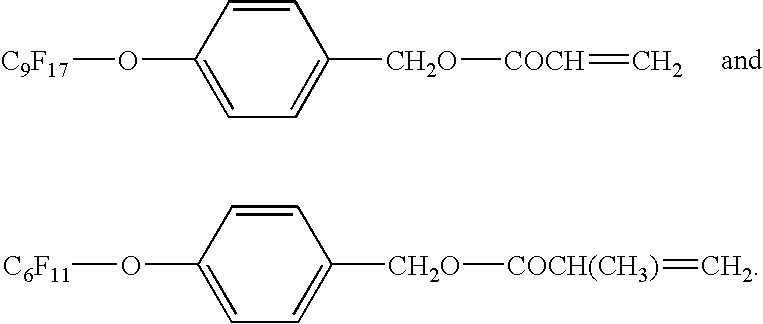Aqueous water-and oil-repellent dispersion
a technology of water-and-oil-repellent dispersions and fibrous fabrics, which is applied in the direction of liquid-repellent fibres, other chemical processes, synthetic resin layered products, etc., can solve the problems of insufficient resistance of fibrous fabrics treated with usual conventional aqueous dispersions, and inability to achieve excellent storage stability of conventional aqueous dispersions
- Summary
- Abstract
- Description
- Claims
- Application Information
AI Technical Summary
Problems solved by technology
Method used
Image
Examples
example 1
100 g of C.sub.n F.sub.2n+1 CH.sub.2 CH.sub.2 OCOCH.dbd.CH.sub.2 (a mixture of compounds wherein n is 6, 8, 10, 12 and 14 (average of n is 8)), 50 g of stearyl acrylate, 2 g of N-methylol acrylamide, 200 g of pure water, 40 g of tripropylene glycol, 0.3 g of acetic acid, 4 g of alkyl trimethyl ammonium chloride and 10 g of polyoxyethylenealkylphenyl ether were charged into a 500 mL flask and emulsified at 60.degree. C. for 15 minutes by means of ultrasonic wave with stirring. 0.75 g of azobisisobutylamidine dihydrochloride was added and the reaction was continued for 5 hours to give an aqueous dispersion of a polymer.
The water- and oil-repellency and the storage stability were evaluated. The results are shown in Table 3.
example 2
100 g of C.sub.n F.sub.2n+1 CH.sub.2 CH.sub.2 OCOCH.dbd.CH.sub.2 (a mixture of compounds wherein n is 6, 8, 10, 12 and 14 (average of n is 8)), 50 g of stearyl acrylate, 2 g of 3-chloro-2-hydroxypropyl methacrylate, 200 g of pure water, 30 g of tripropylene glycol, 0.3 g of acetic acid, 4 g of alkyl trimethyl ammonium chloride and 10 g of polyoxyethylenealkylphenyl ether were charged into a 500 mL flask and emulsified at 60.degree. C. for 15 minutes by means of ultrasonic wave with stirring. 0.75 g of azobisisobutylamidine dihydrochloride was added and the reaction was continued for 5 hours to give an aqueous dispersion of a polymer.
The water- and oil-repellency and the storage stability were evaluated. The results are shown in Table 3.
example 3
100 g of C.sub.n F.sub.2n+1 CH.sub.2 CH.sub.2 OCOCH.dbd.CH.sub.2 (a mixture of compounds wherein n is 6, 8, 10, 12 and 14 (average of n is 8)), 25 g of stearyl acrylate, 25 g of 2-ethylhexyl methacrylate, 200 g of pure water, 80 g of tripropylene glycol, 0.3 g of acetic acid, 4 g of alkyl trimethyl ammonium chloride and 10 g of polyoxyethylenealkyl ether were charged into a 500 mL flask and emulsified at 60.degree. C. for 15 minutes by means of ultrasonic wave with stirring. 0.75 g of azobisisobutyl-amidine dihydrochloride was added and the reaction was continued for 5 hours to give an aqueous dispersion of a polymer.
The water- and oil-repellency and the storage stability were evaluated. The results are shown in Table 3.
PUM
| Property | Measurement | Unit |
|---|---|---|
| weight | aaaaa | aaaaa |
| dispersion | aaaaa | aaaaa |
| resistance | aaaaa | aaaaa |
Abstract
Description
Claims
Application Information
 Login to View More
Login to View More - R&D
- Intellectual Property
- Life Sciences
- Materials
- Tech Scout
- Unparalleled Data Quality
- Higher Quality Content
- 60% Fewer Hallucinations
Browse by: Latest US Patents, China's latest patents, Technical Efficacy Thesaurus, Application Domain, Technology Topic, Popular Technical Reports.
© 2025 PatSnap. All rights reserved.Legal|Privacy policy|Modern Slavery Act Transparency Statement|Sitemap|About US| Contact US: help@patsnap.com


